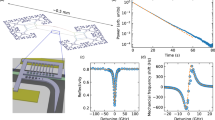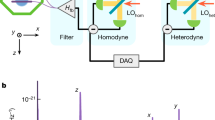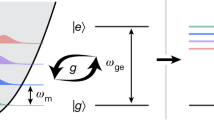Abstract
Controlling a quantum system by using observations of its dynamics is complicated by the backaction of the measurement process—that is, the unavoidable quantum disturbance caused by coupling the system to a measurement apparatus. An efficient measurement is one that maximizes the amount of information gained per disturbance incurred. Real-time feedback can then be used to cancel the backaction of the measurement and to control the evolution of the quantum state. Such measurement-based quantum control has been demonstrated in the clean settings of cavity and circuit quantum electrodynamics, but its application to motional degrees of freedom has remained elusive. Here we demonstrate measurement-based quantum control of the motion of a millimetre-sized membrane resonator. An optomechanical transducer resolves the zero-point motion of the resonator in a fraction of its millisecond-scale coherence time, with an overall measurement efficiency close to unity. An electronic feedback loop converts this position record to a force that cools the resonator mode to its quantum ground state (residual thermal occupation of about 0.29). This occupation is nine decibels below the quantum-backaction limit of sideband cooling and six orders of magnitude below the equilibrium occupation of the thermal environment. We thus realize a long-standing goal in the field, adding position and momentum to the degrees of freedom that are amenable to measurement-based quantum control, with potential applications in quantum information processing and gravitational-wave detectors.
This is a preview of subscription content, access via your institution
Access options
Access Nature and 54 other Nature Portfolio journals
Get Nature+, our best-value online-access subscription
$29.99 / 30 days
cancel any time
Subscribe to this journal
Receive 51 print issues and online access
$199.00 per year
only $3.90 per issue
Buy this article
- Purchase on Springer Link
- Instant access to full article PDF
Prices may be subject to local taxes which are calculated during checkout





Similar content being viewed by others
Data availability
Source Data for Figs. 1–5 are provided with the online version of the paper and are available in the UCPH ERDA repository (https://doi.org/10.17894/ucph.2612dd59-20ab-40d2-a33d-f53e4428c4cd).
References
Braginsky, V. B. & Khalili, F. Y. Quantum Measurement (Cambridge Univ. Press, Cambridge, 1992).
Clerk, A. A., Devoret, M. H., Girvin, S. M., Marquardt, F. & Schoelkopf, R. J. Introduction to quantum noise, measurement, and amplification. Rev. Mod. Phys. 82, 1155–1208 (2010).
Jacobs, K. Quantum Measurement Theory and its Application (Cambridge Univ. Press, Cambridge, 2014).
Wiseman, H. M. & Milburn, G. J. Quantum Measurement and Control (Cambridge Univ. Press, Cambridge, 2009).
Zhang, J., Liu, Y.-X., Wu, R.-B., Jacobs, K. & Nori, F. Quantum feedback: theory, experiments, and applications. Phys. Rep. 679, 1–60 (2017).
Sayrin, C. et al. Real-time quantum feedback prepares and stabilizes photon number states. Nature 477, 73–77 (2011).
Vijay, R. et al. Stabilizing Rabi oscillations in a superconducting qubit using quantum feedback. Nature 490, 77–80 (2012).
Aspelmeyer, M., Kippenberg, T. J. & Marquardt, F. Cavity optomechanics. Rev. Mod. Phys. 86, 1391–1452 (2014).
Chan, J. et al. Laser cooling of a nanomechanical oscillator into its quantum ground state. Nature 478, 89–92 (2011).
Teufel, J. D. et al. Sideband cooling of micromechanical motion to the quantum ground state. Nature 475, 359–363 (2011).
Clark, J. B., Lecocq, F., Simmonds, R. W., Aumentado, J. & Teufel, J. D. Sideband cooling beyond the quantum backaction limit with squeezed light. Nature 541, 191–195 (2017).
Mancini, S., Vitali, D. & Tombesi, P. Optomechanical cooling of a macroscopic oscillator by homodyne feedback. Phys. Rev. Lett. 80, 688–691 (1998).
Cohadon, P. F., Heidmann, A. & Pinard, M. Cooling of a mirror by radiation pressure. Phys. Rev. Lett. 83, 3174–3177 (1999).
Kubanek, A. et al. Photon-by-photon feedback control of a single-atom trajectory. Nature 462, 898–901 (2009).
Bushev, P. et al. Feedback cooling of a single trapped ion. Phys. Rev. Lett. 96, 043003 (2006).
Li, T., Kheifets, S. & Raizen, M. G. Millikelvin cooling of an optically trapped microsphere in vacuum. Nat. Phys. 7, 527–530 (2011).
Jain, V. et al. Direct measurement of photon recoil from a levitated nanoparticle. Phys. Rev. Lett. 116, 243601 (2016).
Poggio, M., Degen, C. L., Mamin, H. J. & Rugar, D. Feedback cooling of a cantilever’s fundamental mode below 5 mK. Phys. Rev. Lett. 99, 017201 (2007).
Kleckner, D. & Bouwmeester, D. Sub-kelvin optical cooling of a micromechanical resonator. Nature 444, 75–78 (2006).
Wilson, D. J. et al. Measurement-based control of a mechanical oscillator at its thermal decoherence rate. Nature 524, 325–329 (2015).
Lee, K. H., McRae, T. G., Harris, G. I., Knittel, J. & Bowen, W. P. Cooling and control of a cavity optoelectromechanical system. Phys. Rev. Lett. 104, 123604 (2010).
LaHaye, M. D., Buu, O., Camarota, B. & Schwab, K. C. Approaching the quantum limit of a nanomechanical resonator. Science 304, 74–77 (2004).
Gavartin, E., Verlot, P. & Kippenberg, T. J. A hybrid on-chip optomechanical transducer for ultrasensitive force measurements. Nat. Nanotechnol. 7, 509–514 (2012).
Vinante, A. et al. Feedback cooling of the normal modes of a massive electromechanical system to submillikelvin temperature. Phys. Rev. Lett. 101, 033601 (2008).
Abbott, B. et al. Observation of a kilogram-scale oscillator near its quantum ground state. New J. Phys. 11, 073032 (2009).
Tsaturyan, Y., Barg, A., Polzik, E. S. & Schliesser, A. Ultracoherent nanomechanical resonators via soft clamping and dissipation dilution. Nat. Nanotechnol. 12, 776–783 (2017).
Thompson, J. et al. Strong dispersive coupling of a high-finesse cavity to a micromechanical membrane. Nature 452, 72–75 (2008).
Nielsen, W. H. P., Tsaturyan, Y., Møller, C. B., Polzik, E. S. & Schliesser, A. Multimode optomechanical system in the quantum regime. Proc. Natl Acad. Sci. USA 114, 62–66 (2017).
Bowen, W. P. & Milburn, G. J. Quantum Optomechanics 103, 161, 163 (CRC Press, Boca Raton, 2016).
Weis, S. et al. Optomechanically induced transparency. Science 330, 1520–1523 (2010).
Peterson, R. W. et al. Laser cooling of a micromechanical membrane to the quantum backaction limit. Phys. Rev. Lett. 116, 063601 (2016).
Gorodetksy, M., Schliesser, A., Anetsberger, G., Deleglise, S. & Kippenberg, T. Determination of the vacuum optomechanical coupling rate using frequency noise calibration. Opt. Express 18, 23236–23246 (2010).
Purdy, T. P., Grutter, K. E., Srinivasan, K. & Taylor, J. M. Quantum correlations from a room-temperature optomechanical cavity. Science 356, 1265–1268 (2017).
Martynov, D. V. et al. Sensitivity of the advanced LIGO detectors at the beginning of gravitational wave astronomy. Phys. Rev. D 93, 112004 (2016).
Schreppler, S. et al. Optically measuring force near the standard quantum limit. Science 344, 1486–1489 (2014).
Kampel, N. S. et al. Improving broadband displacement detection with quantum correlations. Phys. Rev. X 7, 021008 (2017).
Doherty, A. C. & Jacobs, K. Feedback control of quantum systems using continuous state estimation. Phys. Rev. A 60, 2700–2711 (1999).
Doherty, A. C., Habib, S., Jacobs, K., Mabuchi, H. & Tan, S. M. Quantum feedback control and classical control theory. Phys. Rev. A 62, 012105 (2000).
Garbini, J. L., Bruland, K. J., Dougherty, W. M. & Sidles, J. A. Optimal control of force microscope cantilevers. I. Controller design. J. Appl. Phys. 80, 1951–1958 (1996).
Genes, C., Vitali, D., Tombesi, P., Gigan, S. & Aspelmeyer, M. Ground-state cooling of a micromechanical oscillator: comparing cold damping and cavity-assisted cooling schemes. Phys. Rev. A 77, 033804 (2008).
Doherty, A. C., Szorkovszky, A., Harris, G. I. & Bowen, W. P. The quantum trajectory approach to quantum feedback control of an oscillator revisited. Phil. Trans. R. Soc. Lond. A 370, 5338–5353 (2012).
Wieczorek, W. et al. Optimal state estimation for cavity optomechanical systems. Phys. Rev. Lett. 114, 223601 (2015).
Chu, Y. et al. Quantum acoustics with superconducting qubits. Science 358, 199–202 (2017).
Hofer, S. G., Vasilyev, D. V., Aspelmeyer, M. & Hammerer, K. Time-continuous Bell measurements. Phys. Rev. Lett. 111, 170404 (2013).
Hofer, S. G. & Hammerer, K. Entanglement-enhanced time-continuous quantum control in optomechanics. Phys. Rev. A 91, 033822 (2015).
Szorkovszky, A., Doherty, A. C., Harris, G. I. & Bowen, W. P. Mechanical squeezing via parametric amplification and weak measurement. Phys. Rev. Lett. 107, 213603 (2011).
Courty, J.-M., Heidmann, A. & Pinard, M. Quantum locking of mirrors in interferometers. Phys. Rev. Lett. 90, 083601 (2003).
Ringbauer, M., Weinhold, T. J., Howard, L. A., White, A. G. & Vanner, M. R. Generation of mechanical interference fringes by multi-photon counting. New J. Phys. 20, 053042 (2018).
Black, E. D. An introduction to Pound-Drever-Hall laser frequency stabilization. Am. J. Phys. 69, 79–87 (2001).
Leonhardt, U. Measuring the Quantum State of Light Ch. 4.2 (Cambridge Univ. Press, Cambridge, 1997).
Neuhaus, L. et al. PyRPL (Python Red Pitaya Lockbox) — an open-source software package for FPGA-controlled quantum optics experiments. In 2017 Conference on Lasers and Electro-Optics Europe and European Quantum Electronics Conference https://doi.org/10.1109/CLEOE-EQEC.2017.8087380 (Optical Society of America, 2017).
Jayich, A. M. et al. Dispersive optomechanics: a membrane inside a cavity. New J. Phys. 10, 095008 (2008).
Acknowledgements
We acknowledge discussions with K. Hammerer, E. Zeuthen and D. Vitali, and early-stage sample fabrication by Y. Seis. This work was supported by funding from the European Union’s Horizon 2020 research and innovation programme (European Research Council (ERC) project Q-CEOM, grant agreement no. 638765 and FET proactive project HOT, grant agreement no. 732894), a starting grant from the Danish Council for Independent Research and the Carlsberg Foundation.
Reviewer information
Nature thanks D. Bouwmeester, M. Poggio and M. Vanner for their contribution to the peer review of this work.
Author information
Authors and Affiliations
Contributions
M.R., D.M. and J.C. built (with initial contributions from Y.T.) and performed the experiments, analysed the data and, together with A.S., discussed the results and wrote the paper. Y.T. designed and fabricated the membrane resonators. A.S. conceived and directed the project.
Corresponding author
Ethics declarations
Competing interests
The authors declare no competing interests.
Additional information
Publisher’s note: Springer Nature remains neutral with regard to jurisdictional claims in published maps and institutional affiliations.
Extended data figures and tables
Extended Data Fig. 1 Soft-clamped membrane.
a, Photograph of the soft-clamped membrane. b, Simulated displacement pattern of defect-localized mode A. c, Mechanical spectrum of the lowest-frequency bandgap, with defect-localized modes labelled from A to E. The grey peak at 1.09 MHz is a phase-calibration tone.
Extended Data Fig. 2 Mode A ringdowns.
a, Ringdowns with continuous and stroboscopic optical monitoring. The inset shows the power spectral density (PSD) of the continuous ringdown data. b, Ringdowns at different continuous optical powers. The Q values extracted are 1.02 × 109, 1.06 × 109, 1.07 × 109 and 1.04 × 109 from high to low optical power.
Extended Data Fig. 3 Experimental set-up.
An overview of the optical and electronic scheme used in the experiments is shown. AM, amplitude modulator; PM, phase modulator; DAQ, data acquisition card; LIA, lock-in amplifier; aux, auxiliary; νPDH, Pound–Drever–Hall modulation frequency; νcal, calibration tone frequency.
Extended Data Fig. 4 OMIT.
Measured traces of the transmission |tp| are shown for different laser detunings, close to the mechanical frequency Ωm (dashed red line). Black lines are theoretical fits.
Supplementary information
Supplementary Information
This file contains a table with a summary of symbols used throughout the manuscript and three additional sections. In the first one we discuss about the theoretical model used to describe the measurements presented in the manuscript. In the second one we give details about the methods used to analyse the data. In the third section we provide additional measurements which characterize the additional technical noise of the laser source used in the experiment.
Rights and permissions
About this article
Cite this article
Rossi, M., Mason, D., Chen, J. et al. Measurement-based quantum control of mechanical motion. Nature 563, 53–58 (2018). https://doi.org/10.1038/s41586-018-0643-8
Received:
Accepted:
Published:
Issue Date:
DOI: https://doi.org/10.1038/s41586-018-0643-8
Keywords
This article is cited by
-
Room-temperature quantum optomechanics using an ultralow noise cavity
Nature (2024)
-
Real-time two-axis control of a spin qubit
Nature Communications (2024)
-
Ultrahigh-quality-factor micro- and nanomechanical resonators using dissipation dilution
Nature Nanotechnology (2024)
-
Scalable all-optical cold damping of levitated nanoparticles
Nature Nanotechnology (2023)
-
Quadrature nonreciprocity in bosonic networks without breaking time-reversal symmetry
Nature Physics (2023)
Comments
By submitting a comment you agree to abide by our Terms and Community Guidelines. If you find something abusive or that does not comply with our terms or guidelines please flag it as inappropriate.



